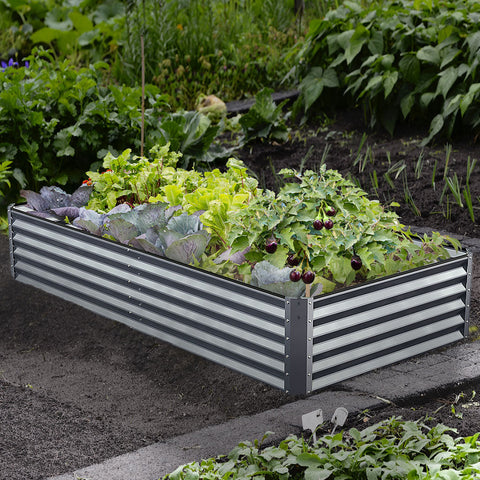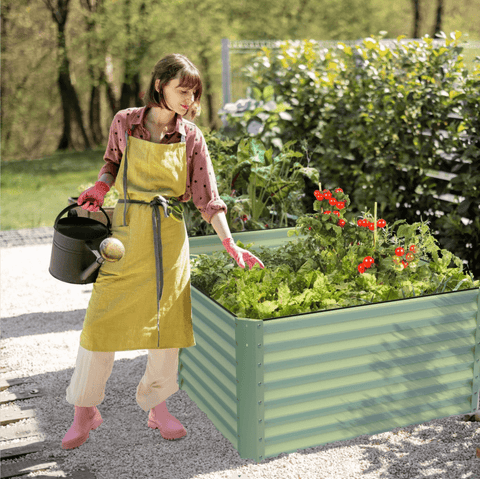Avoid these common accidents and keep your dream container garden from turning into a nightmare.The following content also has some reference value for raised garden beds.
Error 1: Good soil
Good soil is the key to the success of any garden, but for containers, this is even more important because your plants grow in a restricted environment. Remember, any soil can be labeled as' potted soil ', so please read the label before purchasing. High quality potted soil will provide good drainage, plant nutrition, and be able to maintain moisture during drought periods. In addition, it should be sterile and free from weeds or disease pathogens that may cause problems. Based on the aged organic compost, a pot plant mixture of peat moss, vermiculite or perlite is a good choice. Do not directly use the soil in the garden. Even the best topsoil in the world dries too quickly and is not suitable for container use.
Error 2: Selecting the wrong pot
There is an almost infinite selection of pots and containers to choose from. However, you should avoid any areas at the bottom without drainage holes, so that excess water does not accumulate in the soil. Furthermore, please remember that clay pots are a natural material that can breathe, so they dry faster than ceramic or plastic pots. Use clay pots to plant plants that don't mind living in drought, such as succulent plants or cacti. Clay pots are also suitable for other plants, but you must water them regularly. Small flower pots can also be a problem because they cannot hold too much soil and dry quickly. The larger your container better. Tall flowers and vegetables require a lot of soil to grow to prevent them from tipping over.
Error 3: Forgot to drink water
Lack of water may be the primary reason for the failure of container gardens. Generally speaking, most containers require daily watering except during periods of extreme rainfall or when the weather is cool and cloudy in spring and autumn. If you travel frequently, it is wise to set up a drip irrigation system on the timer to water your flowerpot when you are not around. Alternatively, choose plants that don't mind dry conditions and forget to plant more thirsty flowers or vegetables. By the way, watering the container too much is usually not a problem, unless you use a can without a drainage hole.
Error 4: Combining shading plants together
The old saying 'birds of a feather flock together' applies to plants and your bird neighbors. Sunshine loving flowers should not be mixed with shading plants, and vice versa. For example, when you first pair shading plants such as daffodils with sunny geraniums or marigold, they may look beautiful, but ultimately one of the plants will fail, depending on the amount of light received by the container. If you want to buy a pre planted container, carefully check the flowerpot before purchasing, as sometimes these mixtures contain a poorly considered combination of shade and sun loving plants. If you are unsure of the lighting requirements for plants, be sure to read the plant label.
Error 5: Hunger Your Plant
Flowers and vegetables grown in containers will starve. Because they cannot break through the flowerpot and search for nutrients in the field, you need to give them a meal from time to time to keep the flowers or agricultural products flowing. Plants with insufficient nutrition usually grow yellow leaves and stop flowering. To keep your plants happy, feed them a little liquid fertilizer every 10 days or so (follow the label instructions). Your potted plant mixture may also contain slow-release fertilizers, but it is still wise to provide an extra liquid plant-based meal
Error 6: Mixed planting in spring and summer
Some plants prefer cool weather, while others thrive when temperatures soar. If you want to have a colorful garden in spring or autumn, look for varieties that enjoy cold temperatures and be prepared to throw them away when the weather warms up. On the contrary, species with hot weather can suffocate and even die in cool weather. That's why you should never try to mix these two types in the same pot, because at any specific time, one group looks bad while the other group is excellent. Flowers with cool weather, such as pansy and goldfish, are happier together than when forced to share space with hot plants such as zinnia and verbena.
Error 7: Expose plants to the wind
There is nothing sadder than seeing a lush hanging basket slowly withering in the hot wind. Plants are not superheroes. They cannot tolerate very harsh conditions and still look like the day you brought them home from the center of the garden. Avoid placing the hanging basket in an open and windy area, and do not expect a jar or pot filled with flowers to express gratitude to you after self growth and self destruction in an exposed area. Regularly check your jars, and if it seems like they are having a difficult day, move them to a place with less pressure.
Error 8: Let it go
Like people, flowers look and feel much better on spa days. Let them decide for themselves, and without a little extra attention, most flowers will eventually look a bit shabby. Firstly, remove the flower when it fades. This will give plants a better appearance and promote the development of more flowers. Then, use scissors or pruning to trim slender plants, especially vines such as petunias or sweet alysum. Pruning plants can create a cleaner appearance and encourage them to sprout new, more compact growth from the center.
Error 9: Purchase instant satisfaction
If you are looking for prefabricated baskets or containers in the market, look for those that are not fully filled. Garden centers often sell spectacular flower pots that bloom, but these flower pots often have their best days. The younger and fresher the container, the longer you can enjoy it. They may not have bloomed yet, but once you bring them home, their lifespan will be longer. Don't be tempted by the brightest and fullest pot on the shelf.
Error 10: Expectations too high
Annual flowers and vegetables are not redwood; Their lifespan is limited, and once they die, they are easily replaced. Attempting to keep plants alive after their shelf life is futile. Additionally, there are semi dead plants hanging on the side of your container, which will look terrible. Be merciless and pull out any plants that no longer grow. Simply remove the dying plant and replace it with a young, fresh specimen. When it comes to container gardening, there is no room for sentimentality.









